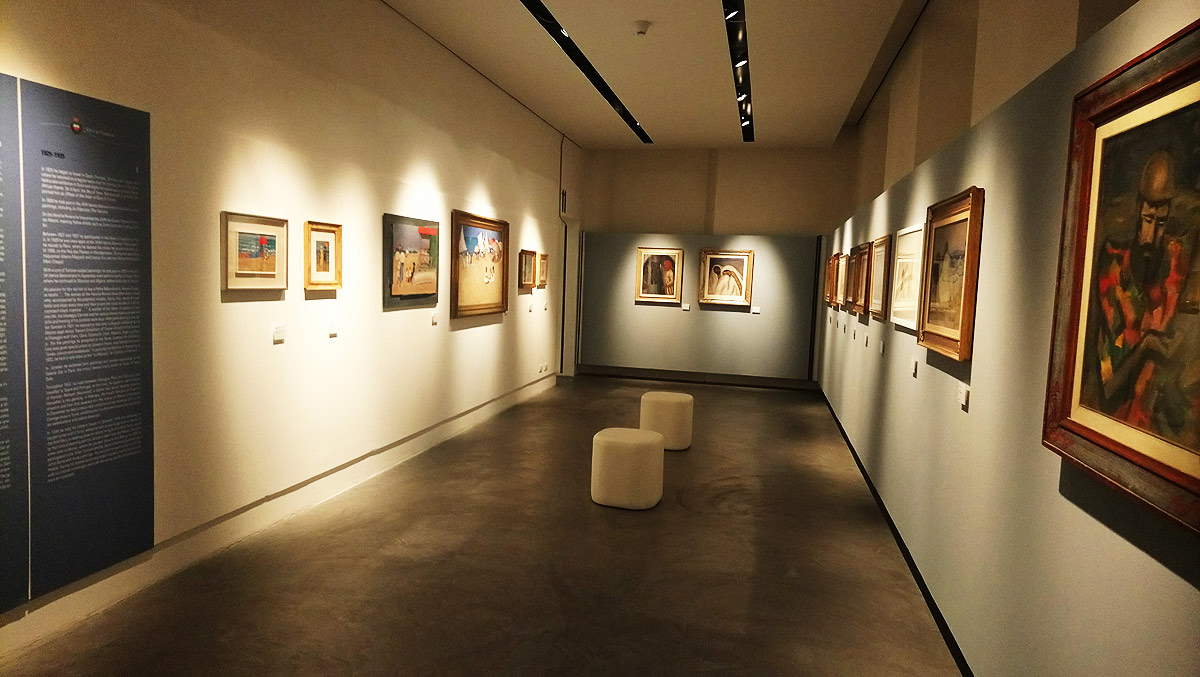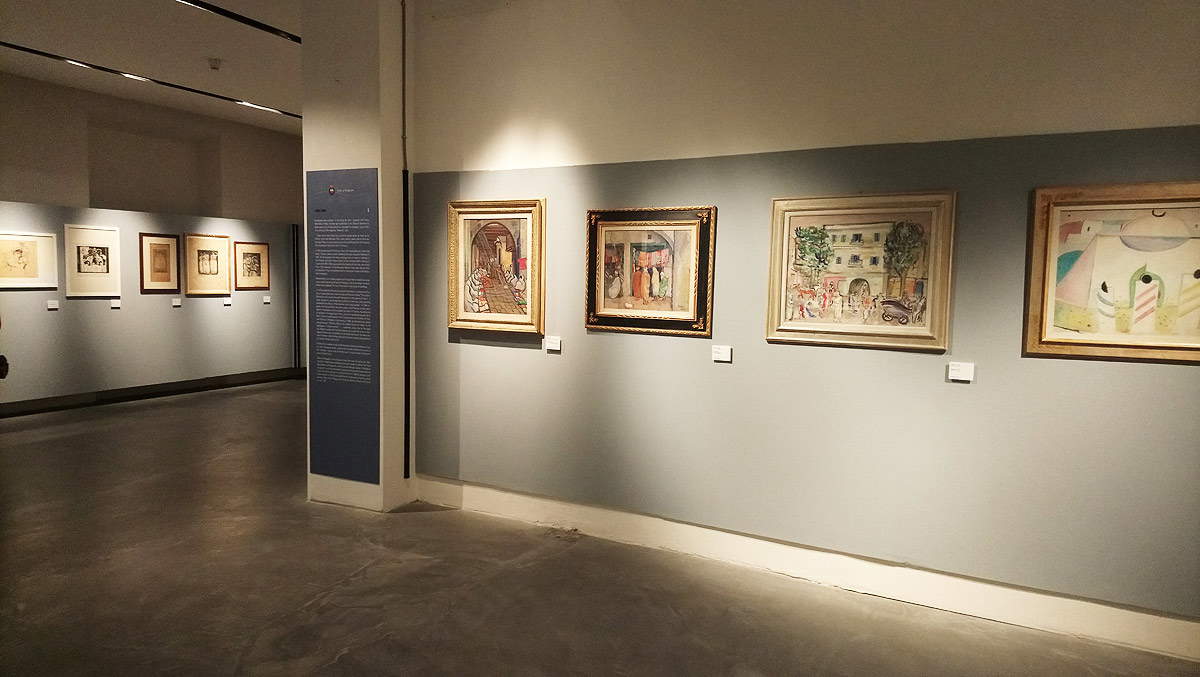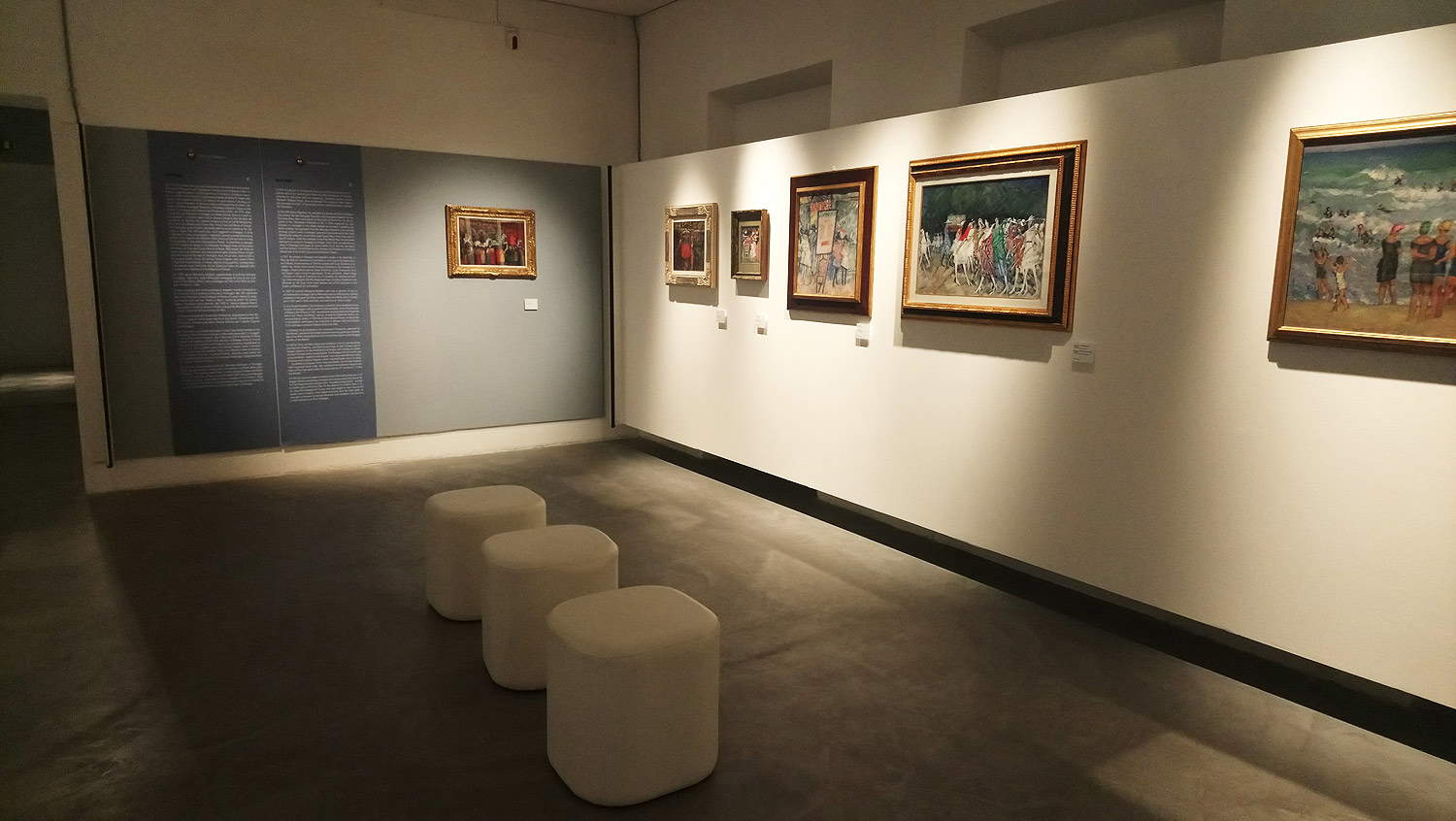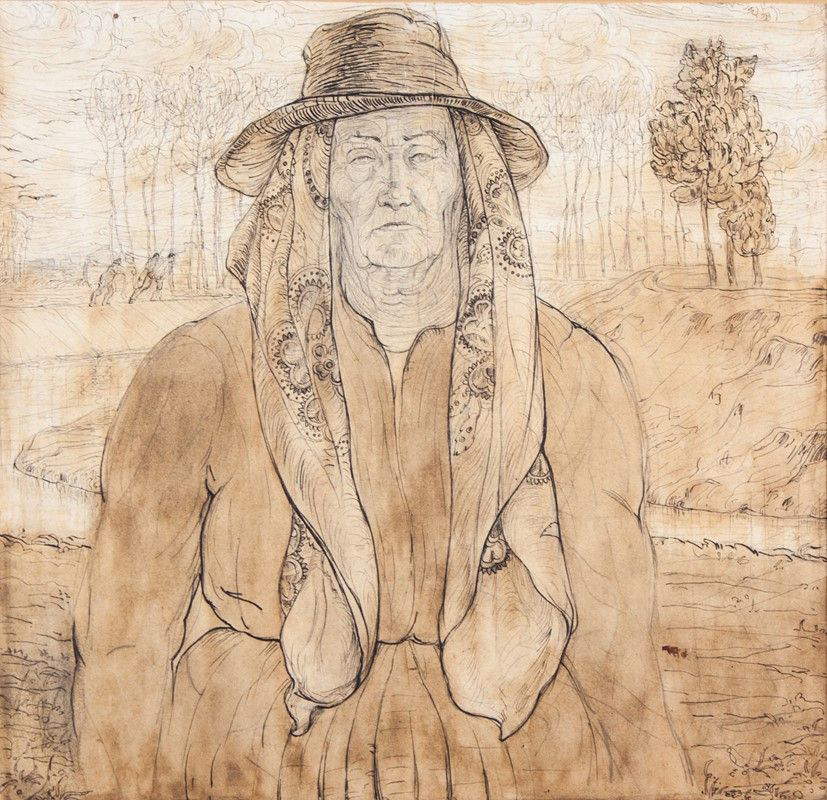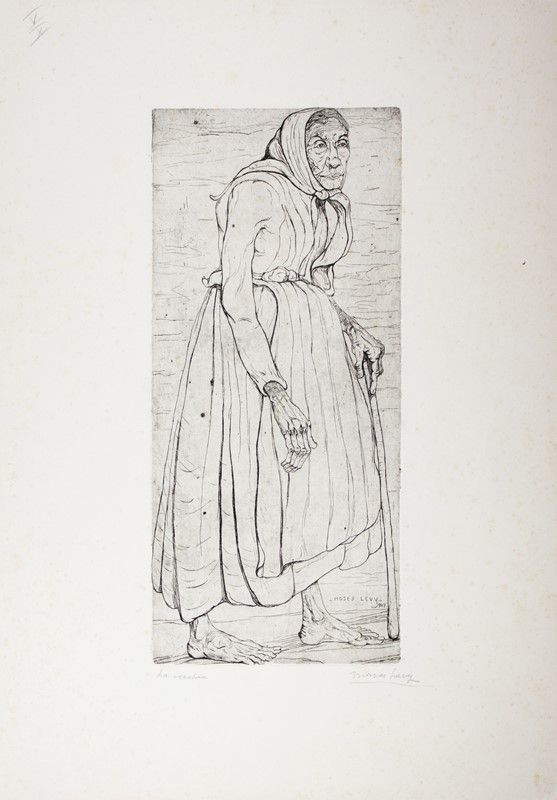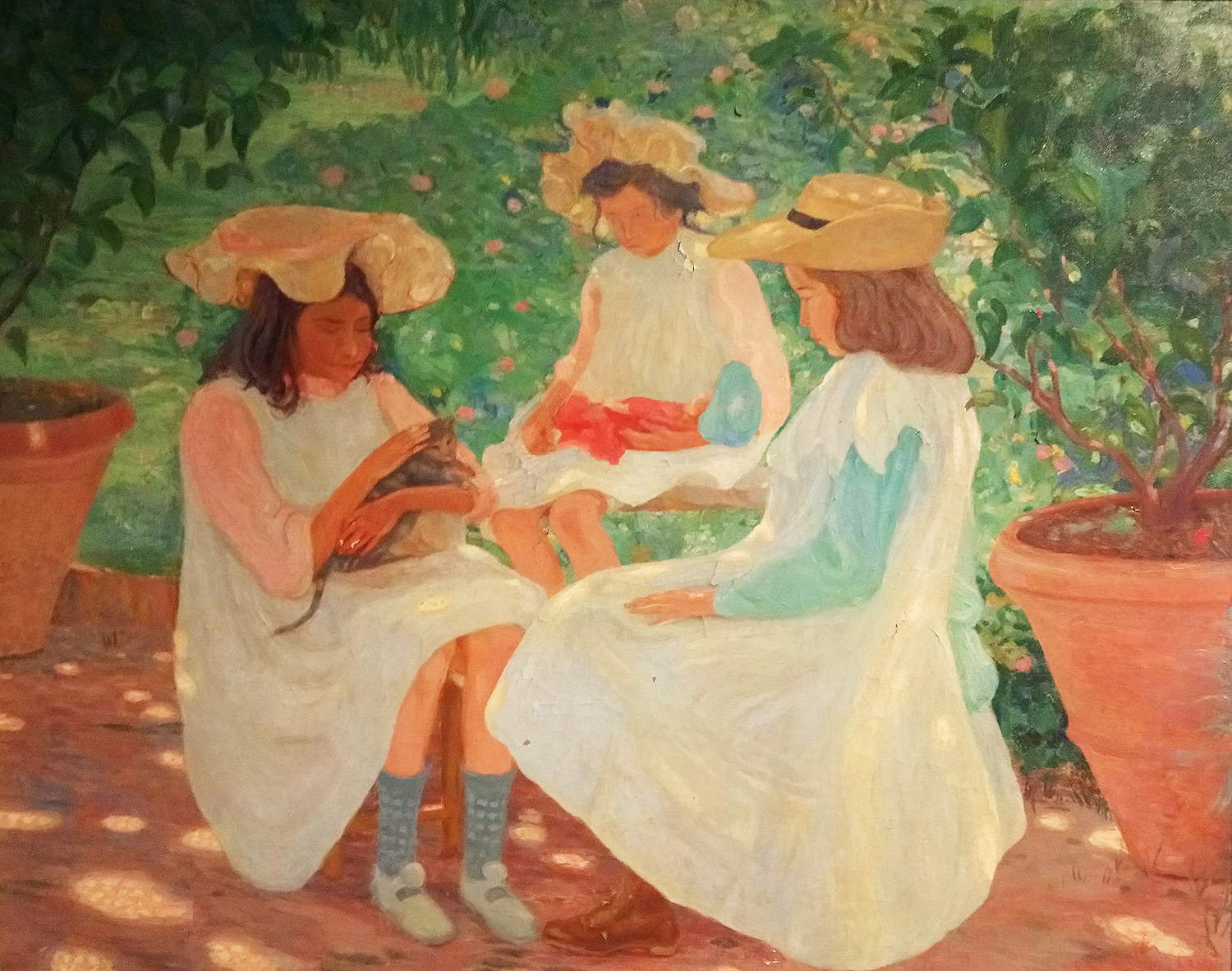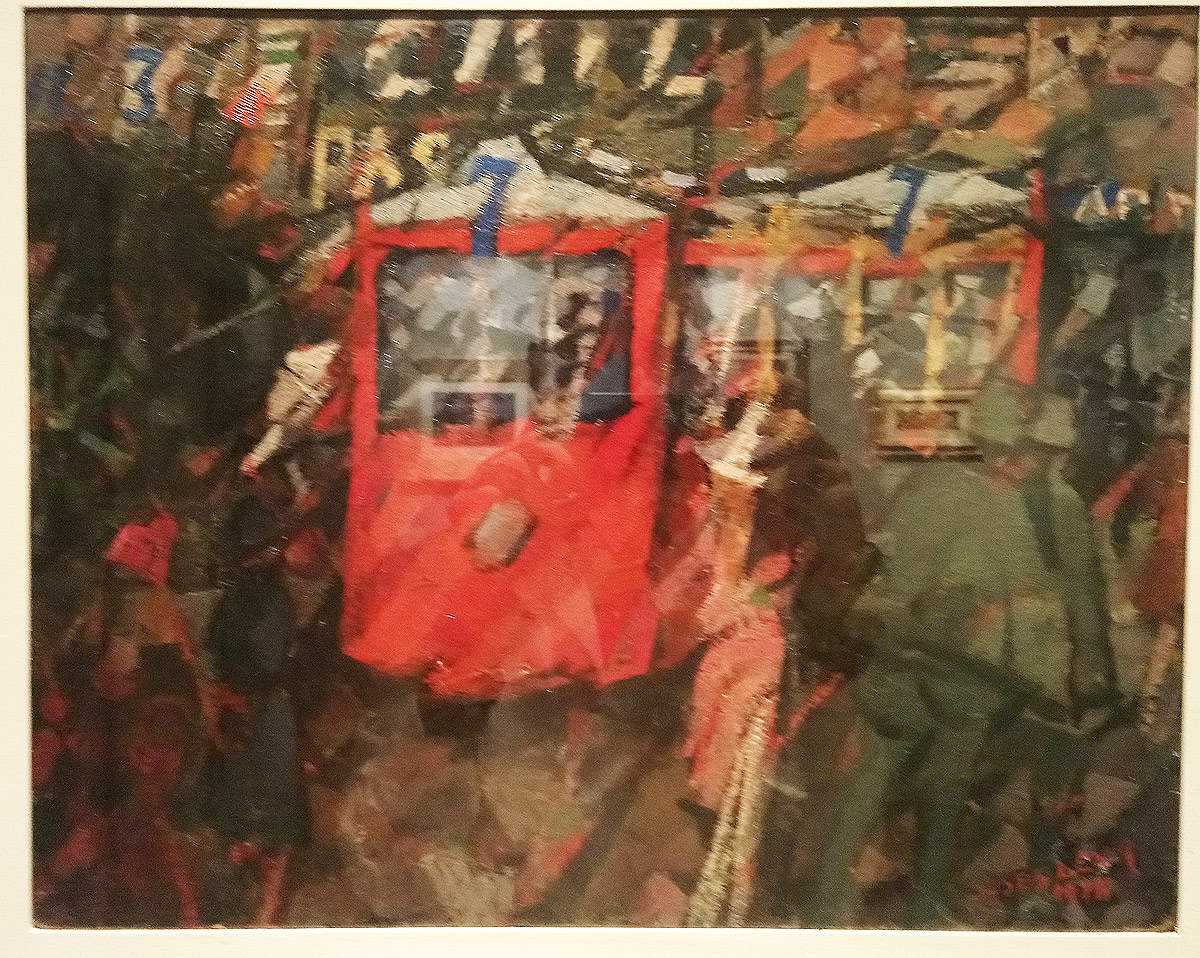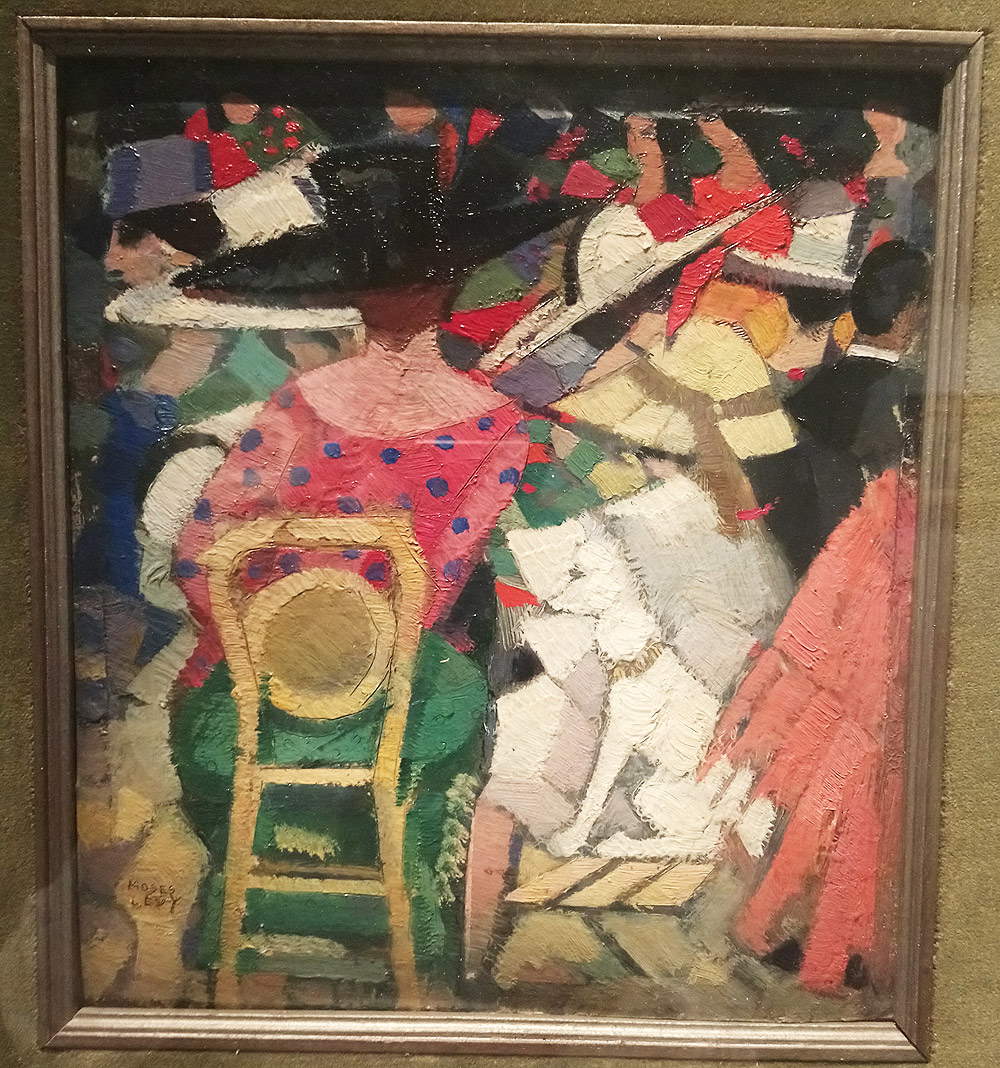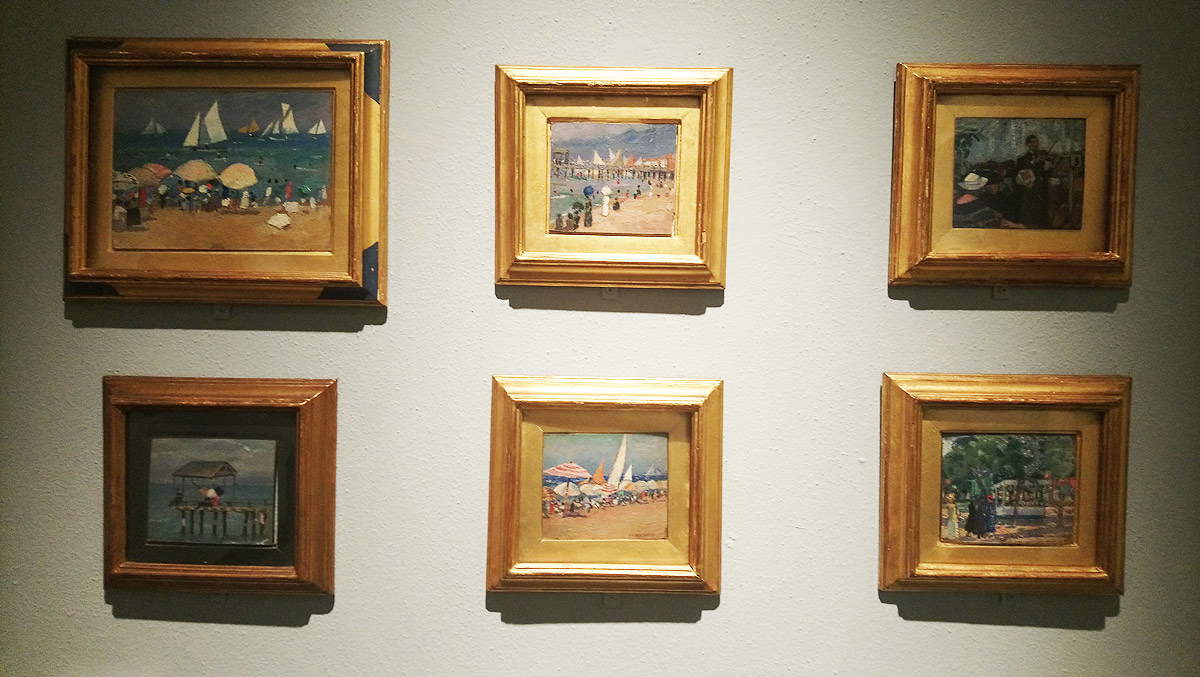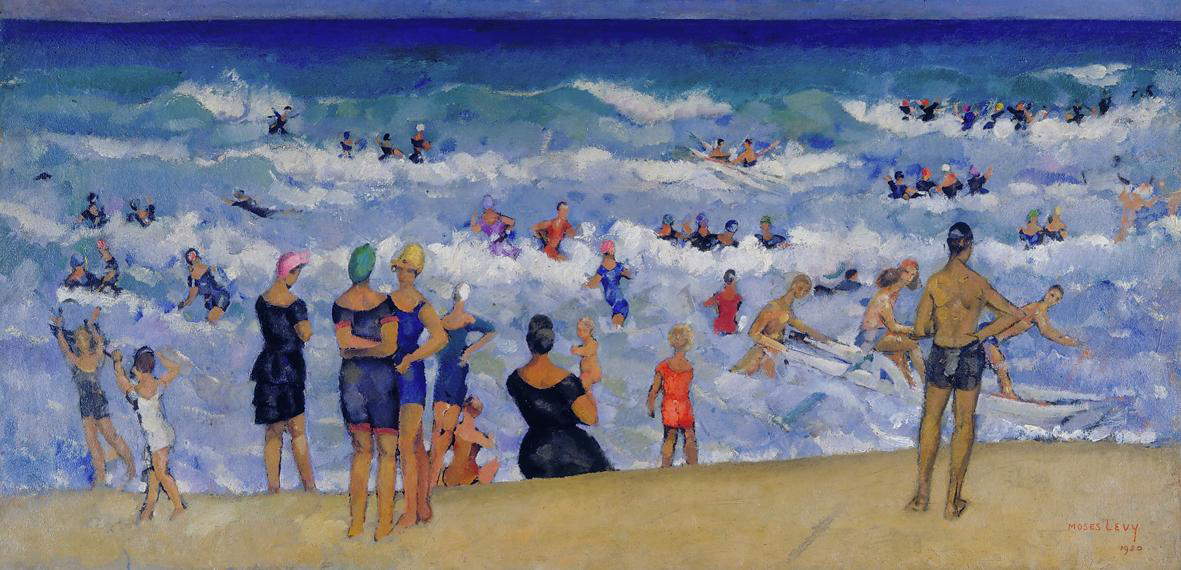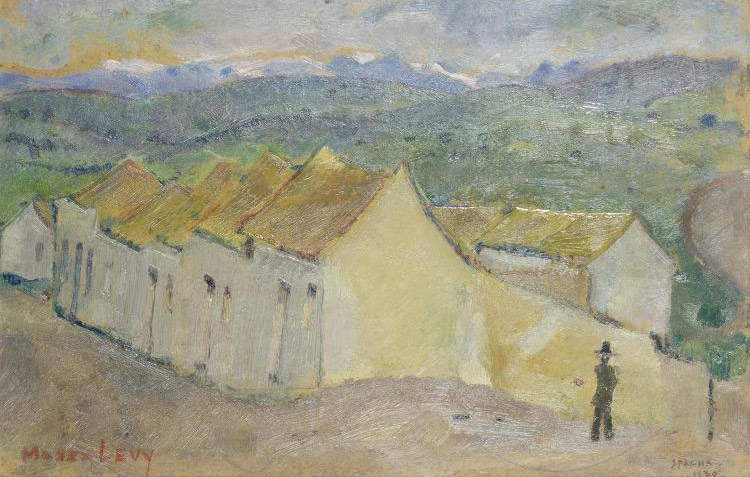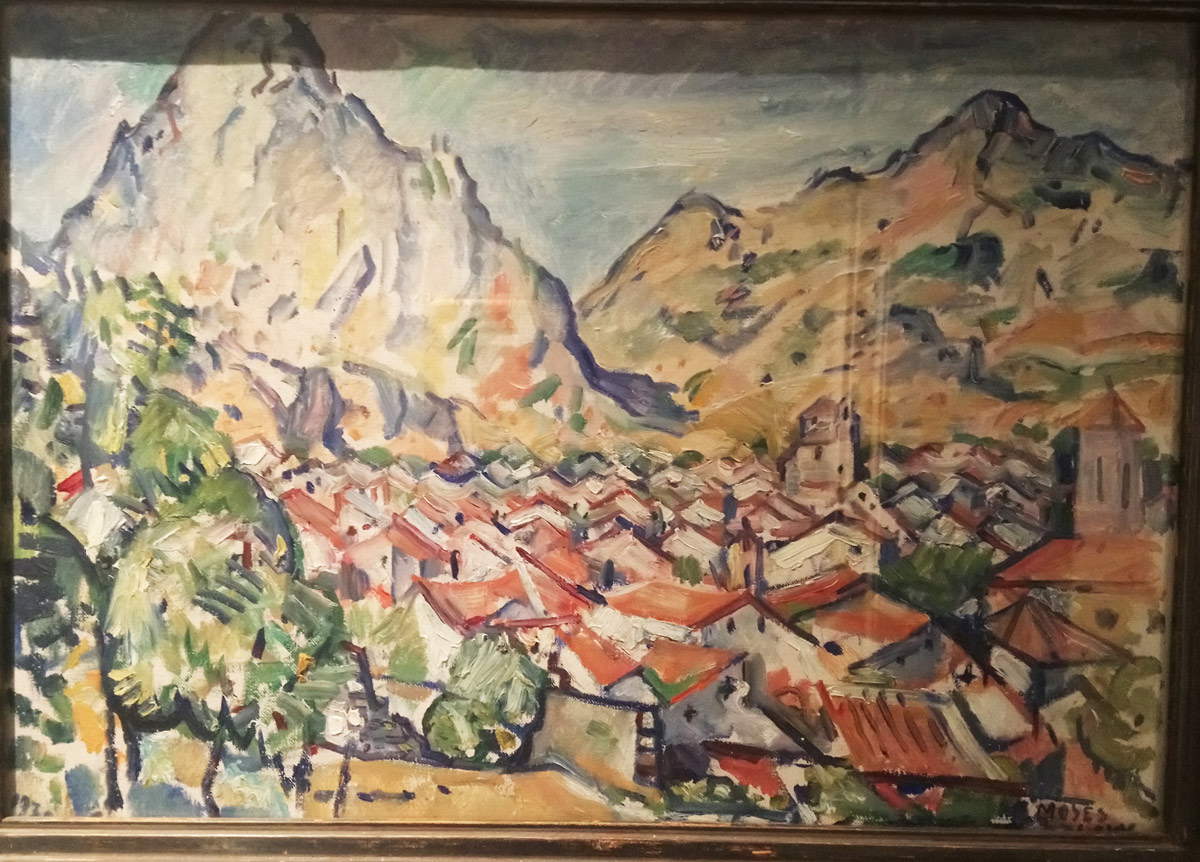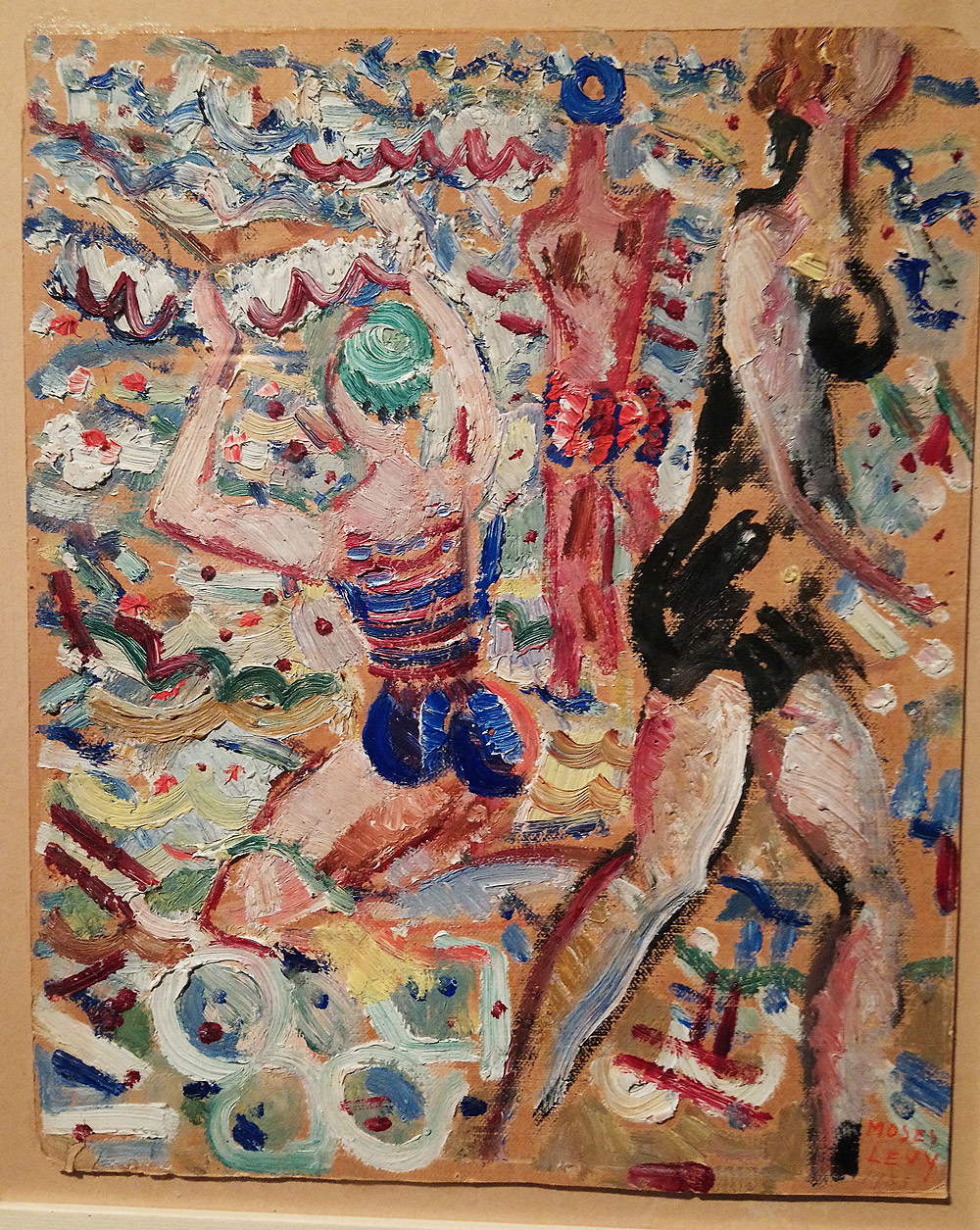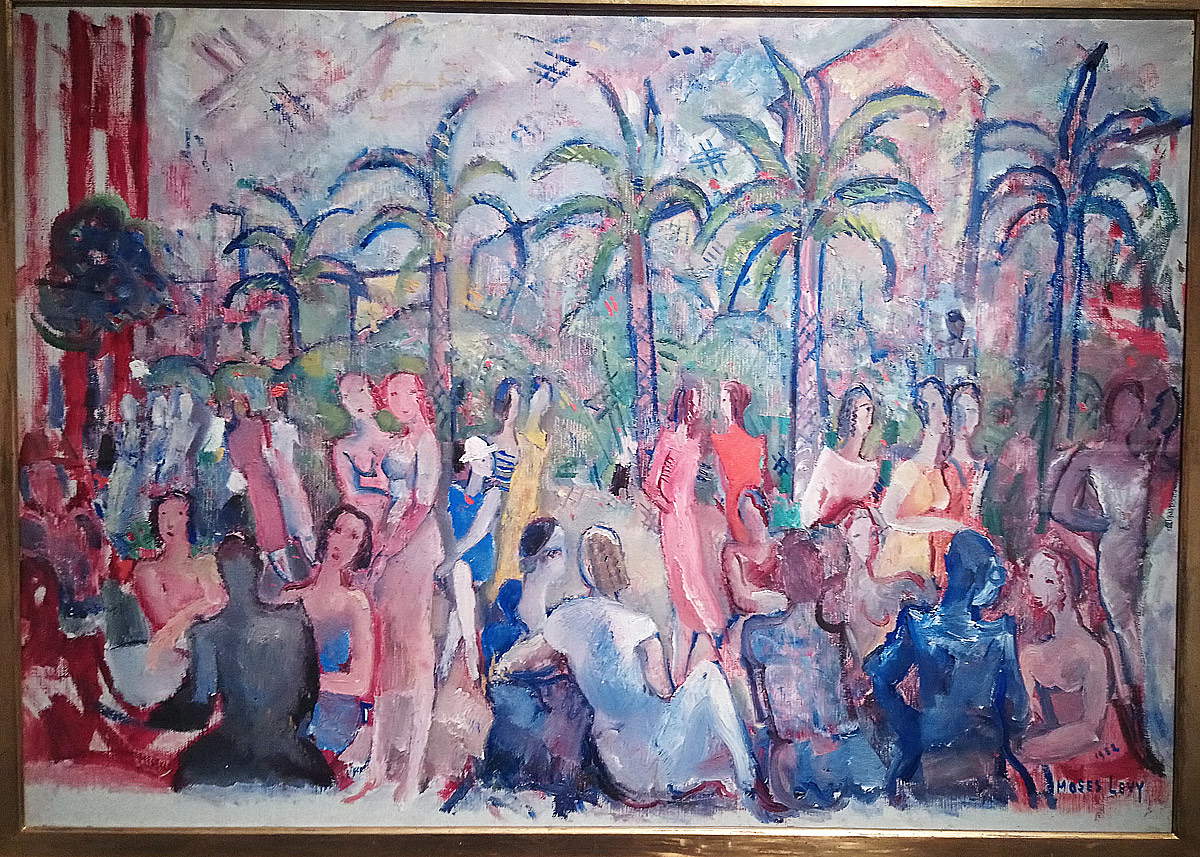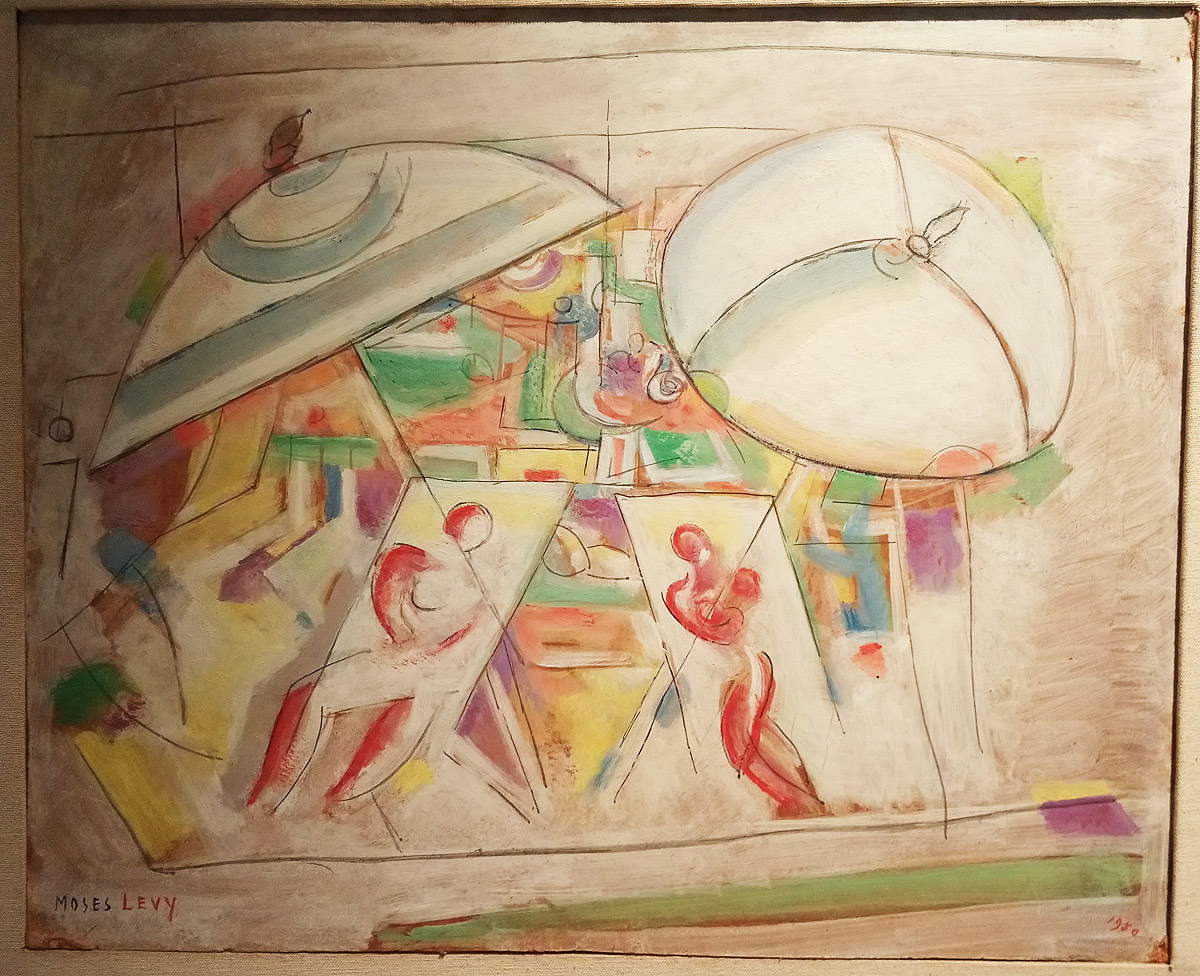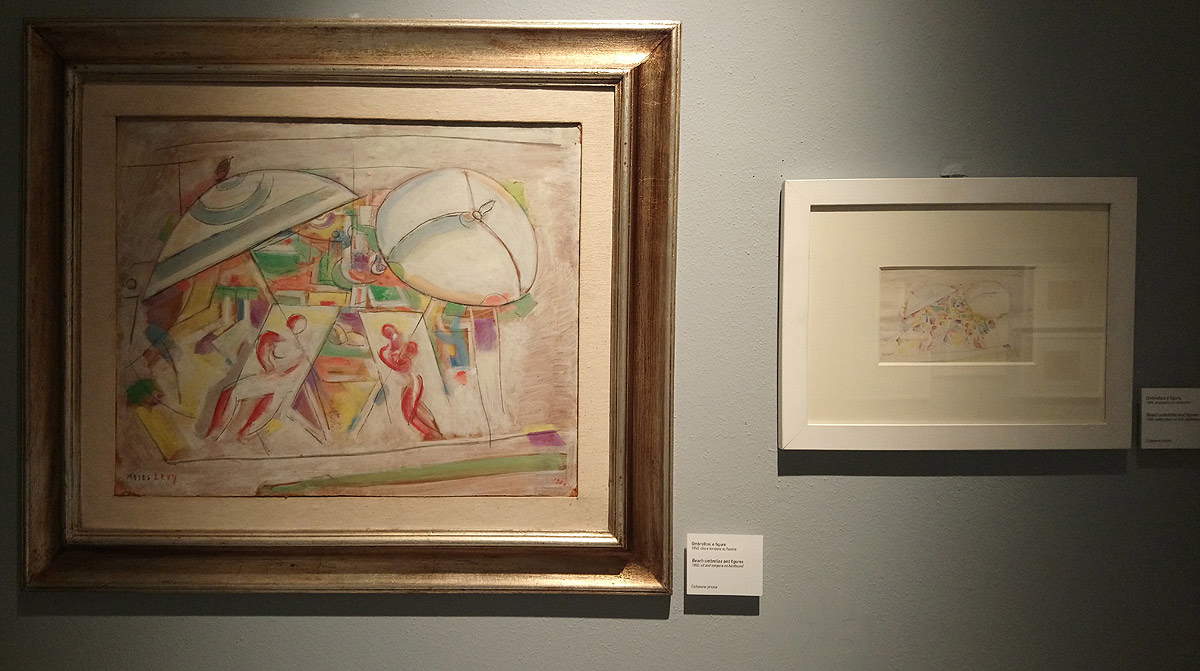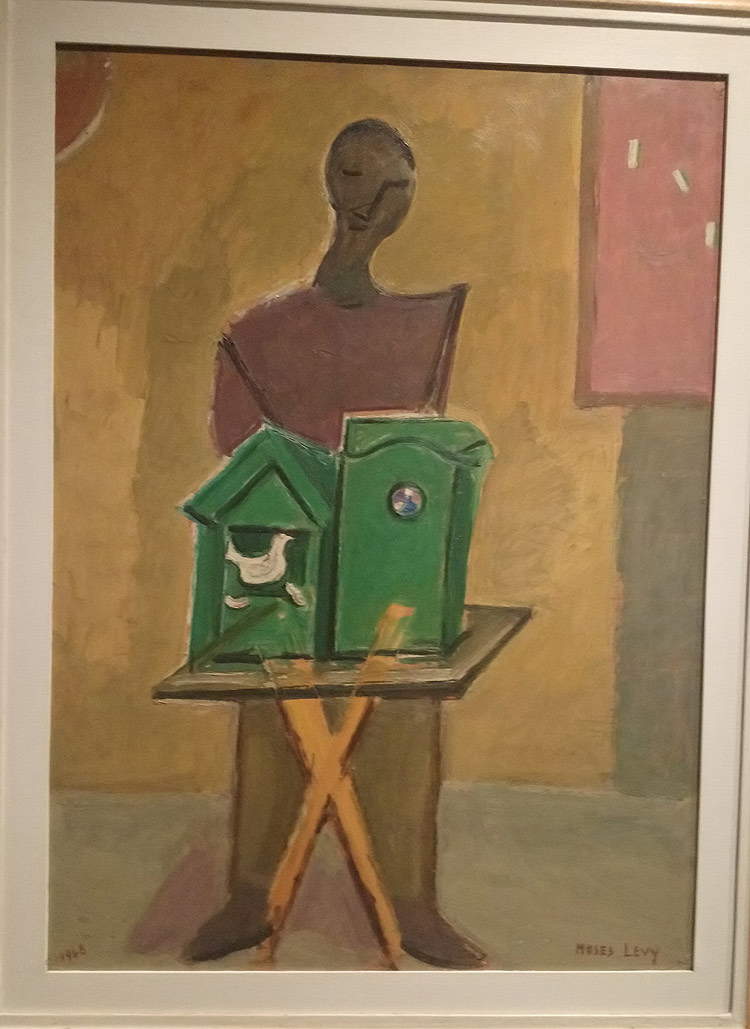by Federico Giannini (Instagram: @federicogiannini1), published on 14/08/2019
Categories: Exhibition reviews
/ Disclaimer
Review of the exhibition "Moses Levy. 'Will Sweetness Return to the Sea,'" in Viareggio, Gallery of Modern and Contemporary Art, Feb. 3 to Sept. 15, 2019.
Perhaps it is not a leap to claim that if today, in our imagination, a certain image of Versilia has been formed (an image made up of elegant promenades on the seafront, of vast beaches dotted with umbrellas of all colors, of evenings among fashionable clubs, of quiet in the shade of pine forests), part of the credit must be ascribed to the painter who more than any other celebrated this Versilia: Moses Levy (Tunis, 1885 - Viareggio, 1968). It was on the sea of Viareggio that Levy found his land of choice, he who was African by birth, English by citizenship, Italian by culture, Jewish by religion and cosmopolitan by mentality, and his story, artistic and personal, unraveled precisely at the time when, between Forte dei Marmi, Pietrasanta, Viareggio and neighboring towns, the institution of the beach vacation, the collective ritual of the weekend at the beach, the celebration of Saturday night in cafes and discos (which were then called dancing clubs) were taking shape. Of that Versilia and that way of life, Levy was the most successful and long-lived interpreter. But it would be reductive to frame Levy in the cliché that has always accompanied him, that of a painter of the beaches: his fortune, which was certainly larger during his lifetime than afterwards, is also linked to the continuous evolutions that, on a formal level, his painting underwent (Levy was a careful investigator and a keen observer of the artistic trends contemporary to him: European cues, suggestions and references are mixed in his painting, not least because Levy often stayed abroad), as well as the variety of themes that led him to give us back an image of Africa devoid of the exoticism that often overshadowed it, or to capture, notably at the beginning of his career, a more intimate and lesser-known Tuscany, made up above all of work in the countryside, or again to account for his many travels between the two shores of the Mediterranean.
Levy is now the protagonist of a new retrospective that his Viareggio dedicates to him: Moses Levy. “Sweetness will return to the sea” is the title of the exhibition that brings more than a hundred works, almost all from private collections, to the Gallery of Modern and Contemporary Art in the Tuscan town that is traditionally not part of historic Versilia but has, by popular acclaim, become part of the commonly understood Versilia. The title is taken from theArietta Settembrina by Alfonso Gatto, another character used to frequent these areas for a long time. The lyric is a kind of ode to the last glimpses of summer that leave the field to autumn: after all, painting the sea is also the same as painting it when everyone has gone away, and one feels the same sensation as when one is left alone after a party is over. Levy’s poem is also that of the sea at the end of summer, when the air becomes colder but gives the atmosphere more vivid colors, when the beaches are now almost deserted, when silence falls over the sea and the countryside: “It will return to the sea / the sweetness of the winds / to open the clear waters / in the green of the currents. / At the harbor, on the sailing ship / of carob trees the summer / darkens, remains black / the dog of the stones. / The countryside of lemons and sand falls asleep / in the song that laments / monotonous of sorrow. / So close to the world / of puny signs, / you rest in the depths / of the sweetness you extinguish.”
As one might expect, the Viareggio exhibition, curated with scrupulous rigor by Alessandra Belluomini Pucci, celebrates the narrative of the sea according to Moses Levy, in every season, in all its possible declinations, throughout his career. But this is not theonly intent. Wanting to attribute two particular merits to the exhibition, one could start with the fact that the one in Viareggio is one of the most comprehensive monographs ever on Moses Levy, an artist who, moreover, lives a very peculiar, if not unique, situation: several exhibitions are dedicated to him, so much so that, including the GAMC exhibition, there are no less than three monographs in the last twenty years, but he is little represented in museums, despite the fame he knew and, above all, the fact that in the past he was supported by first-rate critics. The second lies instead in the Viareggio review’s ability to delve into Moses Levy from the postwar period to the extremes of his activity, a period little addressed by critics: to examine this part of his production, an essay in the catalog written by Francesco Bosetti also intervenes, aimed at shedding new light on the last two decades of the painter’s career. A third, equally considerable one can be added: an unpublished correspondence between Levy and Carlo Ludovico Ragghianti is published in the catalog (edited by Paolo Bolpagni, director of the Ragghianti Foundation), which is useful in making the reader realize the weight Levy had when he was alive and the cultural networks in which he was embedded.
 |
| Moses Levyexhibition hall. “Sweetness will return to the sea.” |
 |
| Moses Levyexhibition hall. "Will the sweetness returnto the sea." |
 |
| Moses Levyexhibition hall. "Sweetness will return to the sea. " |
The beginning, however, is devoted to the beginnings: born in Tunis in 1885, Levy soon moved, along with his entire family, to Florence, where he was already in 1895 (and at the same time the family had already taken to the Viareggio shores). His stay in coastal Tuscany gave him the opportunity to come into contact with Lorenzo Viani (Viareggio, 1882 - Lido di Ostia, 1936), whose friendship probably affected his art more than the studies he made first at the Royal Institute of Fine Arts in Lucca (it was here that Levy met Viani), then at the Academy of Fine Arts in Florence, where he took lessons at Giovanni Fattori’s Scuola Libera del Nudo. The first known attestations of his art (apart from the early adolescent trials) refer to that climate ofintense primitivism that permeated the artistic culture of Versilia at the beginning of the twentieth century and that had its protagonists in Lorenzo Viani, Alberto Magri, Adolfo Balduini and Spartaco Carlini. In the first Levy, too, we can see the desire to propose an anti-academic, almost popular art, aimed at recovering a kind of lost purity. Levy, too, made extensive use ofetching, which was among the main modes of expression of the Italian expressionists, especially those who worked in the coastal area of Tuscany (as has often been noted, etching, and especially woodcut, with its essential, rough and rugged sign, lent itself well to Italian expressionism’s instances of simplification). But, unlike a Magri or a Balduini who sought their roots in medieval and children’s art, Levy’s gaze was broader: The Old Peasant Woman, writes Belluomini Pucci, “restores the stylistic intensity of the Belgian production of Meunier and Laermas, with Central European connotations in the details of popular costume, and with the illustrative suavity of the Swedish Carl Larsson.” Levy remained a restless and curious artist, however: while he produced works such as the aforementioned Old Peasant Woman or The Old Woman (a work that, Belluomini Pucci points out, recalls the lessons of Millet and that of van Gogh: in this case, one would be inclined to add, that of the van Gogh of the Borinage), and while collaborating with L’Eroica, the magazine published in La Spezia that was among the main vehicles for the spread of Italian expressionism, he also painted a work such as Bambine in giardino that, while not renouncing the typical lines of the Fauves, looked blatantly at Nomellini of Versilia (the one, to be clear, of the Baci di sole, a work not on display: unfortunately, there are no comparative works at the GAMC exhibition).
In 1916, Levy gave to the lawyer Luigi Salvatori and the man of letters Enrico Pea the works that were in his studio in Rigoli, a village on the outskirts of Pisa: thus opened a new phase in his art, under the banner of painting and color. The main protagonist of these years is life in the city, interpreted with a synthesis that, declined in different meanings throughout the artist’s career, will nevertheless become the most recognizable element of his art. The Levy of these years treasures the lesson of the Macchiaioli, but updates it with simplified forms that take his scenes to a higher level of abstraction. Look at Folla di sera sul lungomare di Viareggio, Tram n. 7 and Donne al caffè, the latter an unpublished work: these are paintings in which there is a clear caesura compared to the Levy of the early 1910s, in which there is a turning point that almost completely severed ties with past expressionist experiences, and in which the experience of the Futurists is even evident. It is an art that aims to suggest an idea, a moment: Levy’s is not descriptive painting, it is mood painting. In one of his essays from 1958, Alessandro Parronchi, referring precisely to the works of these years, wrote that Levy, breaking away from the expressionism of artists like Magri and Viani, “remains [...] a painter of the present moment, of the feast of colors and lights that still welcome the grace of arabesque, the play of reflections and glimmers, the hasty accentuations of rhythm.” Levy’s is, for Parronchi, “a stylistically guarded art” that the painter “never complitely sacrifices to instinct”: Levy “composes, balances, in a measured and penetrating observation of the real.”
 |
| Moses Levy, The Old Peasant Woman (1906; India ink, bistro and ink on paper, 315 x 310 mm; Viareggio, Private Collection) |
 |
| Moses Levy, The Old Woman (1907; etching, 345 x 155 mm; Viareggio, GAMC - Gallery of Modern and Contemporary Art “Lorenzo Viani”) |
 |
| Moses Levy, Little Girls in the Garden (1909; oil on canvas, 83 x 105 cm; Private collection) |
 |
| Moses Levy, Streetcar No. 7 (1918; oil on panel, 33 x 41 cm; Private collection) |
 |
| Moses Levy, Women at the Café (1918; oil on cardboard, 21 x 21 cm; Private Collection) |
The third room of the exhibition opens with a group of six delightful unpublished works: six small-format canvases, all dating from 1923, that open to the “Beach Levy,” to which much of the exhibition is naturally devoted. The beach strand, to which the artist gave himself for much of the 1920s, represents one of the happiest of his career and, as anticipated, is the one for which he is probably best known to the public. La mareggiata, a work from 1920 with a long exhibition history, takes us directly to the shoreline during a day of rough seas: the foaming of the waves is rendered with soft, dense touches of color, the figures constructed with sharp outlines, the space is also simplified on horizontal bands sharply distinguished into chromatic zones. A way of painting that is almost reminiscent of a mosaic: this is the figure we are wont to assign, on impact, to Levy. We have to imagine the artist while, as he used to do, capturing the scene from life: the bathers diving, the lifeguard entering the sea with his skate, the mothers watching over their children splashing in the waves. A photograph of an ordinary summer day on the Apuo-versiliese coast. The Meriggio al mare of 1921 marks a further change of perspective, destined, however, to have little follow-through: the forms become turgid and sharp, the backgrounds monochromatic and with little variation, the figures almost unreal (Belluomini Pucci picks up on references to the art of Fernand Léger, whom Italian painters were beginning to appreciate in those years). More or less along the same lines is the exhibition’s signature work, Woman with a Parasol, which develops yet another motif of summer by the sea: a solitary woman sunbathing, perhaps at the end of the season, lying on the shore, in the company of her dog. Here, Levy’s art takes on more lyrical and delicate connotations. The modes change, but the underlying assumption remains: to sing that “poetry in the sea sun” (so Ragghianti) to which his art “always rejoins.”
From the beaches of Versilia he then moves on to the deserts of North Africa: Levy often returned to Tunisia (in 1923 he organized a major exhibition in his hometown with thirty-nine engravings and fifty-four paintings, and again in 1924, following the death of his mother, he left Viareggio to return to Tunis where he settled for some time, then returned there in alternating phases until at least 1945), and in the 1930s, in the capital of the African country, he also founded a Groupe des Quatre together with three other artists of different backgrounds and origins (Pierre Boucherle, Antonio Corpora and Jules Lellouche), all, however, animated by the cosmopolitan vision of art and the world. The production of works with African subject matter increased from the 1924 sojourn: these are paintings that retain their fauve soul and remain devoid of any interest in the exotic. If anything, there are some changes in the relationship between figures and space. Two Arabs with the Covered Face is one of the most significant works of this phase: in this painting, Francesca Cagianelli wrote in 2009, Levy proposes “the module of the double figure, this time with renewed rhythmic ambition, by virtue of which the white cloaks are equivalent to simplified backgrounds of an almost abstract outcome, through which only the penetrating bistrate eyes repropose the stereotypes of a femininity as emblematic as it is savage.” Abstraction becomes almost geometric in the works that capture glimpses of the Tunisian landscape, as in The Saint, which gives us in the foreground the tomb of a marabout, a kind of Islamic saint worshipped by the local communities (the tree planted next to the small mausoleum takes the form of an almost perfect oval, the dog against the light on the left is nothing more than a silhouette painted in monochrome, the profiles of the dwellings are cleanly drawn polygons that fit into space, and the construction of the entire composition is always based on the alignment of bands of different colors), or like The Bride’s House, where the oblique perspective that Levy had already experimented with in his Viareggio paintings returns.
During the 1930s travel intensified, and Levy’s art became almost a diary of his experiences in France, Spain, Venice, northern Europe, and northern Africa (where the artist moved between Tunisia, Morocco, and Algeria). The simplification that Levy had achieved in his Tunisian years is echoed in several of his works from this period, starting with a masterpiece like San Roque, with its string of white houses at the edge of a road sloping down to the sea, while in the background the Andalusian village agglomeration looks almost like a theory of overlapping boxes. Soon, however, Levy would graft to his art an unprecedented immediacy that constitutes the salient element of the production of this period: it is precisely the Spanish paintings made from 1931-1932 onward in which these characteristics are best appreciated. That sense of instantaneous improvisation of which Ragghianti spoke about this production leads the artist to paint without preparation, in a shorthand manner (in these years his brushstrokes, Ragghianti wrote, were an “impulsive shorthand”), arriving at a “total, progressive abolition of distance from his theme” (so wrote Gianfranco Bruno in the 2002 Seravezza exhibition catalog): this manner would soon invest his beach views giving rise to scenes much more convulsive and restless than those he made in the 1910s and 1930s ( Bathers and Bathers with Swans are clear examples of this), while not lacking that joie de vivre that connoted his modes of expression. True acmé of these sensations is probably the Passeggiata sotto le palme, not only because it assimilates many of the artist’s technical-stylistic reflections, but also because it is among the highest moments of that “mythopoiesis of Viareggio summer life” of which Riccardo Mazzoni speaks in his catalog essay (and to which Levy, as mentioned in the opening, contributed substantially), and transmits to us the image of a Viareggio with a dreamlike flavor, which transfigures the imagination of the artist, who was very attached to his Tunisia, into a crowded and festive seafront, along which run those palm trees that the painter loved because they reminded him of his homeland, and constitute a constant presence in his “African” paintings.
 |
| Moses Levy, the six unpublished canvases in the Moretti collection |
 |
| Moses Levy, Beach and Apuane (1923; oil on cardboard, 9.5 x 11.5 cm; Moretti Collection) |
 |
| Moses Levy, The Swell (1920; oil on canvas, 60 x 120 cm; Private Collection) |
 |
| Moses Levy, Afternoon at the Sea (1921; oil on canvas, 75 x 115 cm; Private Collection) |
 |
| Moses Levy, Woman with Parasol and Dog on the Beach (1921; oil on cardboard, 21 x 31.5 cm; Private Collection) |
 |
| Moses Levy, The Saint (1925; oil on cardboard, 46 x 62 cm; Private Collection) |
 |
| Moses Levy, San Roque (1930; oil on rintelboard, 70 x 102 cm; Private collection) |
 |
| Moses Levy, Spain (1930; oil on canvas applied to cardboard, 32.5 x 46.5 cm; Private Collection) |
 |
| Moses Levy, Spain, Detail (1932; oil on cardboard, 50 x 70 cm; Viareggio, Private Collection) |
 |
| Moses Levy, Bathers (1933; oil on cardboard, 26.5 x 21.5 cm; Private Collection) |
 |
| Moses Levy, Bathers with Swans, detail (1933; oil on cardboard, 38 x 46 cm; Viareggio, Private Collection) |
 |
| Moses Levy, Strolling Under the Palm Trees (1932; oil on canvas, 70 x 100 cm; Private Collection) |
The last rooms of the GAMC exhibition are devoted to the knot of the last Levy, which the exhibition aims to help solve. Stricken in 1938 by racial laws, the painter had to leave Italy to find refuge first in Nice, then in Tunisia: he would only return to Italy at the end of the war, but without ceasing to remain in contact with his friends. Upon his return, he would continue his activity intensively, never ceasing to exhibit (he was also at the Venice Biennale in 1950: this was the last time he took part in the international art exhibition, thus coming to count no less than ten participations, the first of which was in 1905 when he was only 20 years old, a very precocious talent), continuing to divide his time between Italy and Tunisia, where he was among the main animators of the Salon Tunisien, and concentrating his personal exhibitions mainly in his native Tuscany. As mentioned above, Francesco Bosetti devotes an in-depth essay to Moses Levy after 1945, noting that the last two decades of the painter’s activity aroused little interest in the critics, despite his intense activity (which, however careful, did not remain on the same levels of originality as that between the two wars) that was substantiated by a large number of works produced in this turn of the year and, above all, by an equally intense exhibition activity. The reasons for the little attention paid to him are identified in several factors: his lack of relations with the main cultural centers of the postwar period (except for a few sporadic cases, such as his participation in the aforementioned Venice Biennale of 1950, which in any case had no effect on his fortunes), the fact that Levy had no ties with the great dealers and gallery owners, his living in the suburbs (he divided his time between Tunis and Viareggio, without forgetting Florence, however, where he had a studio: but the frequency was not constant). Direct consequence was the scant consideration by contemporary critics (except, again, a few isolated voices). Thus, Bosetti notes, scholars have settled on positions that have not sufficiently deepened the postwar Levy, often consigning him to an almost stereotyped image: “there is a lack,” Bosetti points out, “of a real, scientific and systemic analysis that places with true historical and even before that aesthetic coherence the last two decades of Levy’s work, in the total of the author’s production and experience.”
The painting of the last Levy is thus subjected to an unprecedented analysis that does not intend to arrive at definitive conclusions: if anything, by and large, it seems to aim to open a discussion. The theme of the seaside view came back into vogue in the last years of Levy’s activity, albeit with new declinations: for example, some works such as Horses by the Sea, with its evocation of De Chirico, seem to open up to metaphysics. Among the favorite subjects then remain the views of Tunisia, the views of Venice, those of French cities, although there is a renewed interest in the human figure, especially in the Tunisian production. On the stylistic level, it is impossible not to take into account the turn in an abstract direction that Levy imprints on his art from the end of the 1940s: certainly, not all of his production from that period fits into this strand (Moses Levy is, after all, an artist who is very difficult to classify and label, not least because of the fact that when he takes one path he does not stop following another and does not turn all his attentions towards a single direction), but it is nonetheless research that opens up a new phase of experimentation. They are studies “in which the decomposition of the figure, the modulation of the real even in a cubist sense, the fragmentation of the chromatic trace itself,” Bosetti points out, “denounce a rovello, an investigation into the possibilities of the sign, which translates in later painting into references, on closer inspection, very present.” In the exhibition we realize this from works such as Umbrellas and Figures, displayed next to a watercolor that probably constitutes a preparatory study. Another significant work is Seller of Birds, a 1948 work in which the research on abstraction invests the figure of the protagonist, reaching its most extreme consequences. In the years when research on sign painting was intensifying in Italy, Levy, despite being at the end of his career, showed that he could feel the echo of what was happening around him.
 |
| Moses Levy, Horses on the Sea (1946; oil on canvas, 60 x 90 cm; Private collection) |
 |
| Moses Levy, Umbrellas and Figures (1950; oil and tempera on faesite, 50 x 61 cm; Private collection) |
 |
| Moses Levy, Parasols and Figures with his watercolor |
 |
| Moses Levy, Seller of Birds (1948; oil on faesite, 73 x 53 cm; Angemi Collection) |
From the exhibition at the GAMC in Viareggio emerges a portrait of Levy that corresponds to the one succinctly frescoed by Bosetti: an artist who “traverses an unrepeatable, rare experiential arc, outside any notion of immobility of techniques, language, themes and places, while extraordinarily immersed (and with extraordinary sensitivity and concreteness) in the culture of the Short Century.” Even without works by other artists that would have provided additional context (although it should be noted that the Viareggio exhibition has one more advantage over previous Levy monographs: it is held at the GAMC where, in fact, the context is already largely present, since the visitor can get to know up close, for example, the figure of Lorenzo Viani, or that of Levy’s son, Nello, who picked up his legacy), the itinerary imagined by Alessandra Belluomini Pucci stands out for its completeness, for the presence of several previously unpublished works, and for its openness to new perspectives of research on the art of Levy, an artist who is still rather underestimated. The catalog, composed of essays by the curator, by the aforementioned Bolpagni, Bosetti and Mazzoni, and by Marzia Ratti who examines the years in which Levy collaborated with Ettore Cozzani’s L’Eroica, stands out for its ability to sketch in a concise (but rigorous and with ample recourse to contemporary sources) way a dense and complete profile of the artist, strong also in documents never published until now.
Finally, it is necessary to adduce a final and important consideration. Levy’s artistic personality, as we have seen, was the result of the encounter of different cultures. It has often been emphasized how Levy, although he considered himself an “Italian painter, or rather a Tuscan” despite his English citizenship (thus in one of the unpublished letters to Ragghianti published by Paolo Bolpagni), was an artist with a plural identity, as well as the spokesman of a wide, open, inclusive world, devoted to multiplicity, in which the sea, so beloved, his horizon, becomes not only a place in which to spend pleasant moments, but also a metaphor for connection among peoples. The sea is perhaps the one element that recurs in the production of all the places where Levy stayed. His incessant moving between one shore and the other of the Mediterranean made him an exceptionally refined and sensitive artist: Liliana Segre, who was entrusted with the introduction to the catalog, places the emphasis on the fact that this sensitivity of his allowed him to transform personal and collective dramas into positive energy, which took shape in the vitalistic impulse that never abandoned him. And this, says Segre, is “the best contribution that an artist and an intellectual can offer to their time and to the struggle against the forces of evil: to point out and walk the way to a higher level of civilization and humanity.” This peculiar trait of the Moses Levy man and artist is certainly not a new subject, but it is useful to reiterate it in this age of new identity obsessions, of the upsurge of nationalist instances and claims, of walls being built. For Levy’s art, there were no barriers.
Warning: the translation into English of the original Italian article was created using automatic tools.
We undertake to review all articles, but we do not guarantee the total absence of inaccuracies in the translation due to the program. You can
find the original by clicking on the ITA button. If you find any mistake,please contact us.
